Conteúdos
● Personal pronouns (pronomes pessoais);
● Possessive pronouns (pronomes possessivos);
● Reflexive pronouns (pronomes reflexivos);
● Demonstrative pronouns (pronomes demonstrativos);
● Indefinite pronouns (pronomes indefinidos);
● Relative pronouns (pronomes relativos); e
● Interrogative pronouns (pronomes interrogativos).
Objetivos
● Compreender a importância dos pronomes na Língua Inglesa;
● Aprender as funções dos pronomes em inglês (pronouns), de acordo com suas classificações.
Palavras-Chave:
Inglês. Pronomes. Pronouns. Classificação dos pronomes.
Proposta de Trabalho:
Para começar, trataremos do uso dos pronomes na Língua Inglesa. Em seguida, abordaremos a função dos pronomes, de acordo com suas classificações. Para finalizar, veremos alguns exercícios sobre o tema.
1ª Etapa: O que são os pronouns? Para que servem?
Assim como na Língua Portuguesa, na Inglesa há um grupo de palavras destinado a substituir os substantivos, com o objetivo de evitar construções textuais repetitivas: os pronouns.
Classificados em sete categorias principais, eles são essenciais tanto para a compreensão de textos quanto para a construção de frases (escritas ou faladas).
2ª Etapa: Classificação dos pronouns
Os pronouns são classificados da seguinte forma:
● Personal pronouns (pronomes pessoais);
● Possessive pronouns (pronomes possessivos);
● Reflexive pronouns (pronomes reflexivos);
● Demonstrative pronouns (pronomes demonstrativos);
● Indefinite pronouns (pronomes indefinidos); e
● Relative pronouns (pronomes relativos).
3ª Etapa: Personal pronouns (pronomes pessoais)
Os personal pronouns são utilizados para falar de pessoas, lugares ou objetos, e dividem-se em:
a) Subject pronouns: atuam como sujeito da oração, como na frase “She is a teacher“.
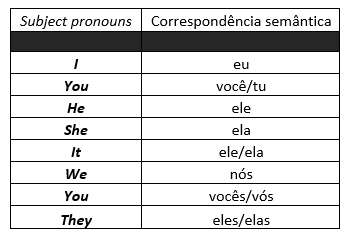 b) Object pronouns: atuam como objeto da oração, como na frase “I live with her“.
b) Object pronouns: atuam como objeto da oração, como na frase “I live with her“.
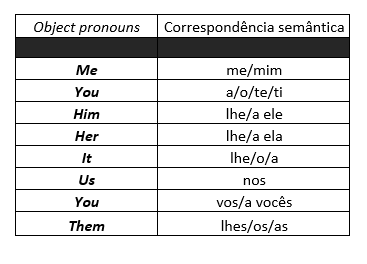
4ª Etapa: Possessive pronouns (pronomes possessivos)
Os possessive pronouns indicam posse, e dividem-se em:
a) Possessive adjectives: modificam o sujeito e devem vir posicionados antes do objeto a que se referem, como na frase “My dog is white“.
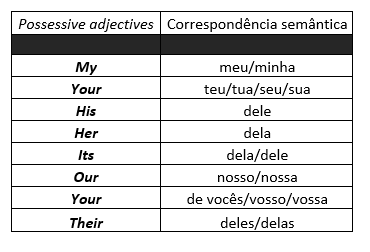
b) Possessive pronouns: substituem o sujeito, evitando sua repetição, portanto não devem acompanhá-los e posicionam-se, usualmente, no final da frase. Por exemplo: This bag is mine.
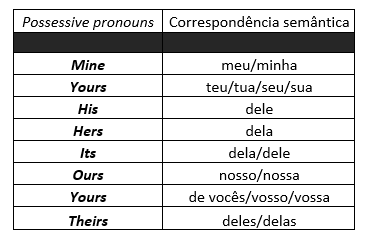
5ª Etapa: Reflexive pronouns (pronomes reflexivos)
Os reflexive pronouns são utilizados para falar de algo que recai sobre o próprio sujeito, e caracterizam-se pela pela terminação -self, no singular, e -selves, no plural. Por exemplo: I told myself that everything is gonna be okay.
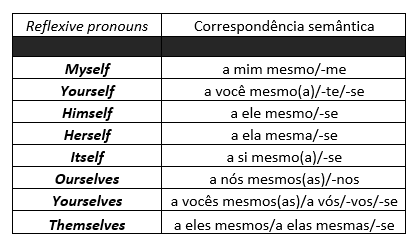
Os reflexive pronouns também podem ser utilizados com o objetivo de enfatizar o sujeito da oração. Neste caso, eles podem aparecer imediatamente após o sujeito da oração ou ao final dela. Sua remoção não altera de forma significativa o sentido do texto, como na frase: I made this cake myself.
6ª Etapa: Quadro-resumo
Para consolidar os conhecimentos obtidos até o momento, veja abaixo uma tabela que demonstra a correspondência dos pronomes em suas diferentes classificações:
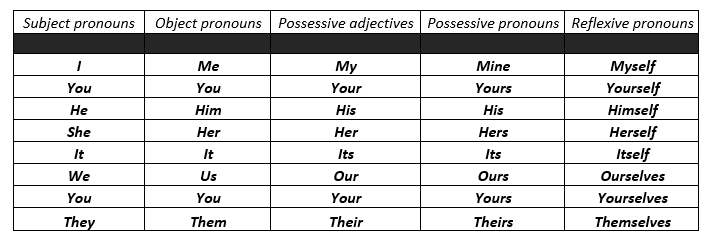
7ª Etapa: Demonstrative pronouns (pronomes demonstrativos)
Os demonstrative pronouns são utilizados para demonstrar algo, pode ser um lugar, uma pessoa ou um objeto. Por exemplo: This is my notebook.
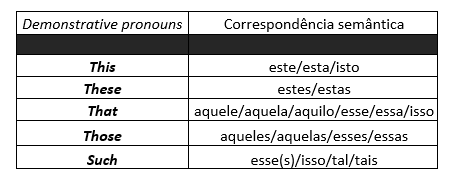
8ª Etapa: Indefinite pronouns (pronomes indefinidos)
Os indefinite pronouns são utilizados para demonstrar, substituir ou acompanhar um sujeito indefinido, como na frase: Any of us can go first.
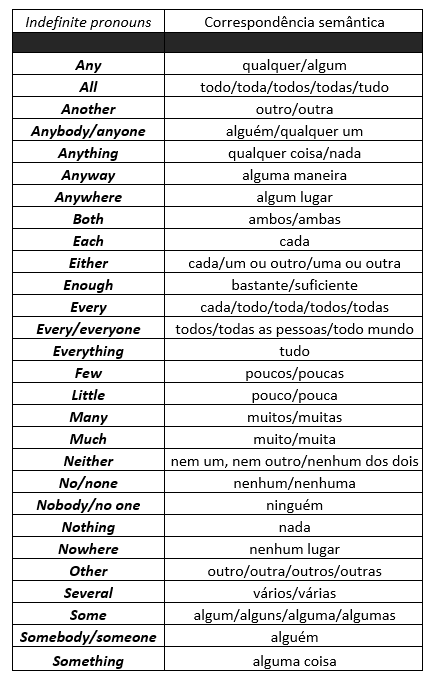
9ª Etapa: Relative pronouns (pronomes relativos)
Os relative pronouns são utilizados para fazer referência a algo que já foi dito no texto, como na frase: She is who told me about the meeting.
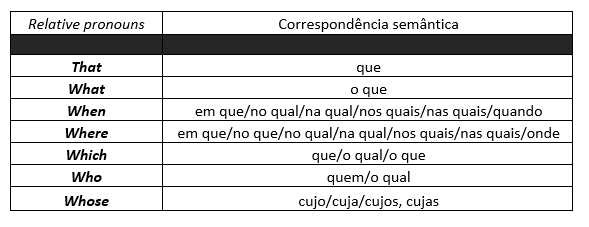
10ª Etapa: Questões retiradas de vestibulares
Seguem abaixo alguns exemplos de como o tema usualmente aparece nas provas. O gabarito está depois das questões.
1) (USP-2018)
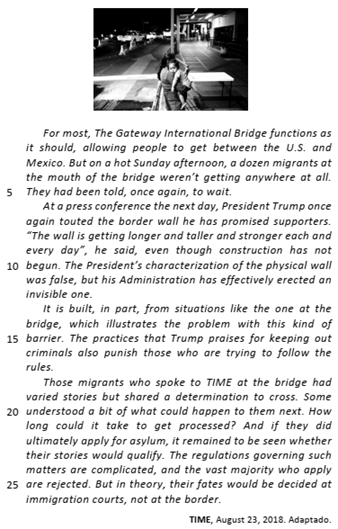
A frase nominal “this kind of barrier” (L. 14‐15) refere‐se:
a) ao muro de Trump na fronteira com o México.
b) à ponte The Gateway International Bridge.
c) a protestos de migrantes na fronteira.
d) ao mundo invisível criado por práticas do governo Trump.
e) a medidas adotadas nos tribunais de imigração.
Disponível em: https://www.qconcursos.com/questoes-de-vestibular/questoes/d17ab622-f2
2) (Instituto Federal Norte de Minas Gerais – 2017)

Nathalie du Toit, the South African swimmer, was only seventeen when she lost her leg in a road accident. She was going to a training session at the swimming pool on her motorbike when a car hit her. Her leg had to be amputated at the knee. At the time she was one of South Africa’s most promising young swimmers. Everybody thought that she would never be able to swim competitively again.
But Nathalie was determined to carry on. She went back into the pool only three months after the accident. And just one year later, at the Commonwealth Games in Manchester, she swam 800 meters in 9 minutes 11:38 seconds and qualified for the final – but not for disabled swimmers, for able-bodied ones! Although she didn’t win a medal, she still made history.
‘I remember how thrilled I was the first time that I swam after recovering from the operation – it felt like my leg was there. It still does,’ says Nathalie. The water is the gift that gives me back my leg. I’m still the same person I was before the accident. I believe everything happens in life for a reason. You can’t go back and change anything. Swimming was my life and still is. My dream is to swim faster than I did before the accident.’
Oxeden, C; KOENIG, C. New English File. Intermediate Student’s Book. OXFORD University Press. (3c-47).
Os adjetivos possessivos (possessive adjectives) são palavras que têm a função de modificar um substantivo, indicando propriedade ou posse. Em todas as frases a seguir, retiradas do TEXTO 01, há um adjetivo possessivo, EXCETO:
a) “…when a car hit her.”
b) “…was only seventeen when she lost her leg in a road accident.”
c) “She was going to a training session at the swimming pool on her motorcycle.”
d) “Her leg had to be amputated at the knee.”
Disponível em: https://www.qconcursos.com/questoes-de-vestibular/questoes/6e5db956-1b
3) (FATEC – 2015)
Learn ‘n’ go
How quickly can people learn new skills?
Jan 25th 2014 – from the print edition
In 2012, Erik Brynjolfsson and Andrew McAfee took a ride in one of Google’s driverless cars. The car’s performance, they report, was flawless, boring and, above all, “weird”. Only a few years earlier, “We were sure that computers would not be able to drive cars.” Only humans, they thought, could make sense of the countless, shifting patterns of driving a car – with oncoming (1) traffic, changing lights and wayward (2) jaywalkers (3).
Machines have mastered driving. And not just driving. In ways that are only now becoming apparent, the authors argue, machines can forecast home prices, design beer bottles, teach at universities, grade exams and do countless other things better and more cheaply than humans. (…)
This will have one principal good consequence, and one bad. The good is bounty(4). Households will spend less on groceries, utilities and clothing; the deaf will be able to hear, the blind to see. The bad is spread(5). The gap is growing between the lucky few whose abilities and skills are enhanced(6) by technology, and the far more numerous middle-skilled people competing for the remaining(7) jobs that machines cannot do, such as folding towels and waiting at tables. (…) People should develop skills that complement, rather than compete with computers, such as idea generation and complex communication. (…)
Glossário
1. oncoming: iminente; próximo.
2. wayward: desobediente; instável.
3. jaywalker: pedestre imprudente.
4. bounty: recompensa.
5. spread: propagação; extensão.
6. enhanced: aprimorado(a).
7. remaining: remanescente.
O pronome relativo whose, em negrito no terceiro parágrafo, refere-se a:
a) the gap.
b) growing.
c) between.
d) technology.
e) the lucky few.
Disponível em: https://www.qconcursos.com/questoes-de-vestibular/questoes/919029bd-b1
4) (PUC-SP – 2018)
Responda à questão de acordo com o texto de Lauren Camera.
Supreme Court Expands Rights for Students with Disabilities
By Lauren Camera, Education Reporter – March 22, 2017. Adaptado.
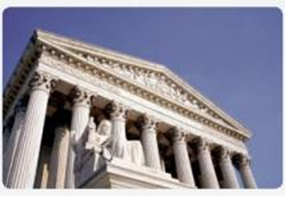
In a unanimous decision with major implications for students with disabilities, the U.S. Supreme Court ruled Wednesday that schools must provide higher educational standards for children with special needs. Schools must do more than provide a ‘merely more than de minimis’ education for students with disabilities and instead must provide them with an opportunity to make “appropriately ambitious” progress in line with the federal education law.
“When all is said and done,” wrote Chief Justice John G. Roberts, “a student offered an education program providing a ‘merely more than de minimis’ progress from year to year can hardly be said to have been offered an education at all.” He continued, citing a 1982 Supreme Court ruling on special education: “For children with disabilities, receiving an instruction that aims so low would be equivalent to ‘sitting idly… awaiting the time when they were old enough to drop out.’”
There are roughly 6.4 million students with disabilities between ages 3 to 21, representing roughly 13 percent of all students, according to Institute for Education Statistics. Each year 300,000 of those students leave school and just 65 percent of students with disabilities complete high school.
The case which culminated in the Supreme Court decision originated with an autistic boy in Colorado named Endrew. His parents pulled him out of school in 5th grade because they disagreed with his individualized education plan. Under federal law, the Individuals with Disabilities Education Act (IDEA), schools must work with families to develop individualized learning plans for students with disabilities.
While Endrew had been making progress in the public schools, his parents felt his plan for that year simply replicated goals from years past. As a result, they enrolled him in a private school where, they argued, Endrew made academic and social progress.
Seeking tuition reimbursement*, they filed a complaint with the state’s department of education in which they argued that Endrew had been denied a “free appropriate public education”. The school district won the suit, and when his parents filed a lawsuit in federal district court, the judge also sided with the school district. In the Supreme Court case, Endrew and his family asked for clarification about the type of education benefits the federal law requires of schools, specifically, whether it requires ‘merely more than de minimis’, or something greater.
“The IDEA demands more,” Roberts wrote in the opinion. “It requires an educational program reasonably calculated to enable a child to make progress appropriate in light of the child’s circumstances.”
*reimbursement – a sum paid to cover money that has been spent or lost.
In:<https://www.usnews.com/news/education-news/articles/2017-03-22/supreme-court-expands-rights-for-students-with-disabilities> 30.03.2018
No excerto do sexto parágrafo “whether it requires ‘merely more than de minimis’, or something greater”, a palavra it se refere a:
a) Federal law.
b) family.
c) education.
d) Supreme Court.
Disponível em: https://www.qconcursos.com/questoes-de-vestibular/questoes/626ac4fc-b0
Gabarito
1) d) ao mundo invisível criado por práticas do governo Trump.
“This kind of barrier” faz menção, por meio do demonstrative pronoun “this”, ao “mundo invisível criado por práticas do governo Trump”.
2) a) “…when a car hit her.”
Nesta frase, “her” é um object pronoun, não representando noção de posse, como é o caso das demais alternativas.
3) e) the lucky few.
O relative pronoun whose refere-se, neste caso, ao termo “the lucky few”.
4) a) Federal law.
O personal pronoun it refere-se, neste caso, a “Federal law”.
Roteiro de Estudos elaborado pela Professora Daniela Leite Nunes




